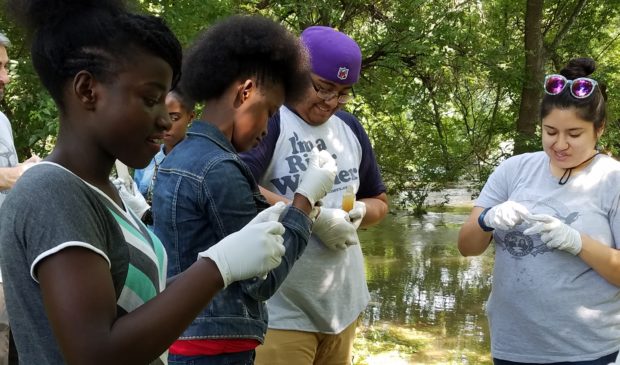Environmental Commission recommends funds for river watchers
Thursday, August 11, 2016 by
Cate Malek The health of Austin’s rivers is carefully monitored on a regular basis by a team of experts. But some of those experts are much younger than many people may realize.
Austin Youth River Watch has been training at-risk high school students to check the levels of pollutants in the city’s natural waterways since 1992. The program was started as a response to rising dropout rates in Austin’s schools. The program has been successful, with 100 percent of participating students having gone on to graduate from high school.
But River Watch staff members are requesting continued city support to keep the program at its current size. The Environmental Commission agrees. Members voted unanimously at their meeting on Aug. 3 to recommend that City Council continue its support of the organization.
“The excellent work of this organization provides an extra set of eyes and ears on Austin’s local environment,” commissioners wrote in a draft recommendation.
Currently, approximately 120 students from 10 high schools around the city are working as river watchers. They receive a small stipend, which allows them to participate in the program instead of getting an after-school job. In exchange, they monitor the water quality at 27 sites around Austin, checking about two sites every day. The students also work with local environmental organizations to design and implement their own service projects to contribute to the health of local rivers.
River Watch staff members focus on recruiting students from low-income and minority communities. Although the statistics vary from year to year, in general, 85 percent of the program’s participants are eligible for free or reduced lunch, 58 percent are Latino, 25 percent are African-American and 51 percent are female.
“The students are learning … that anyone can do science regardless of your background, what ZIP code you live in, what race or ethnicity you are, or what gender you are,” Melinda Chow, the program’s executive director, told the commission.
The program’s statistics seem to bear that message out. In addition to the high graduation rates, 40 percent of the students participating in the program decide to pursue science, math or engineering after graduating from high school, Chow told the commission.
Right now, Austin Youth River Watch is operating on a budget of close to $400,000, Chow said. It’s currently receiving around $170,000 of that budget from the Parks and Recreation Department and the Watershed Protection Department, and it’s asking the city to continue to support the program in its Fiscal Year 2016-2017 budget.
PARD provided the program with $76,000 for just one year. The Watershed Protection Department provided $93,500, eligible for an extension of up to three years. Because Austin Youth River Watch runs on a small staff of three full-time positions, Chow said the city funding is a key part of the organization’s funding.
“If we didn’t have that, it would be a sad program,” Chow said. “I’m not sure we’d be able to do this without the city.”
The program has faced a number of challenges over the past year, including the discovery of asbestos in its main office, which meant that the staff had no base of operations for 15 months while the asbestos was removed.
“We were basically couch surfing for 15 months,” Chow said.
But she emphasized that the program has been able to expand despite being homeless, and it has increased the number of students it serves over the past year.
“At the end of the day, the students feel good that they actively did something good to improve their community,” she said.
Photo courtesy of Austin Youth River Watch.
This story has been corrected to reflect 40 percent, not 47 percent, of participating students decide to pursue science, math or engineering.
The Austin Monitor’s work is made possible by donations from the community. Though our reporting covers donors from time to time, we are careful to keep business and editorial efforts separate while maintaining transparency. A complete list of donors is available here, and our code of ethics is explained here.
You're a community leader
And we’re honored you look to us for serious, in-depth news. You know a strong community needs local and dedicated watchdog reporting. We’re here for you and that won’t change. Now will you take the powerful next step and support our nonprofit news organization?







